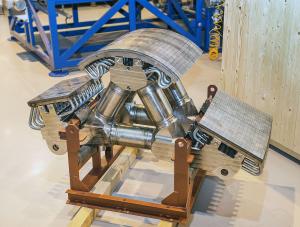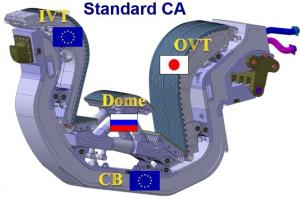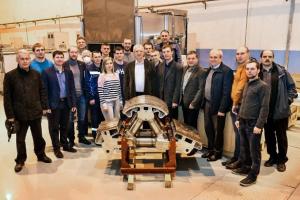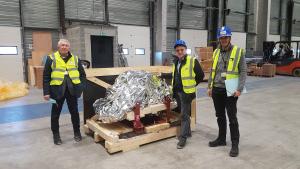Russia delivers a full-scale prototype
A multiyear qualification program in Russia has concluded with the successful manufacturing and testing of a full-scale divertor dome prototype at the Efremov Institute in Saint Petersburg—one of the main suppliers of the Russian Domestic Agency. At ITER it will enter the first divertor integration trials, where prototypes of all divertor components produced by Europe, Japan and Russia will be assembled for the first time.
In a tokamak device, the divertor is the component at the base of the plasma chamber that extracts heat and ash produced by the fusion reaction, minimizes plasma contamination, and protects the surrounding walls from thermal and neutronic loads. The divertor is carefully engineered to withstand large heat and particle fluxes on its plasma-facing surfaces—the inner and outer vertical targets and the dome—while providing exhaust channels for the escaping material.
Arranged in a circle at the bottom of the vacuum vessel, the divertor is made up of 54 "cassette assemblies"—each one formed from an actively cooled structural backbone (the cassette body) in austenitic steel and copper alloy, plasma-facing elements covered in tungsten tiles and, for some cassettes, diagnostic systems. The vertical targets directly intercept the magnetic field lines and are designed to withstand heat fluxes as high as 20 MW/m²; the dome, located between the two divertor channels, may face heat fluxes up to 10 MW/m².
In producing the full-scale dome prototype, engineers at the Efremov Institute of Electrophysical Equipment (JSC NIIEFA) had to learn how to master a series of technical operations (welding, machining, brazing the tungsten tiles) in full respect of extremely tight dimensional tolerances and leak tightness requirements. The tolerances are especially demanding on the plasma-facing surfaces and on the underside of the component, where the dome will be attached to the divertor cassette.
The dome prototype arrived at ITER in December 2021. The next qualification step will be to create the first divertor assembly by integrating the dome prototype and prototypes of the inner (European Domestic Agency, Fusion for Energy) and outer vertical targets (ITER Japan) onto a full-scale prototype of the divertor cassette body (Fusion for Energy).
According to the machine assembly schedule, the 58 divertor dome units are expected on site between 2023 and 2027.





